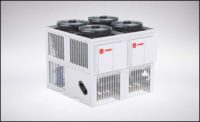In the U.S., energy consumption for water heating is 19% of residential, 23% of lodging, and 11% of health care energy use (EIA, 2018). Despite this high consumption, the total energy provided by solar is small (Berenbaum and Datta, 2020). For example, a California Solar Initiative–Thermal (CSI-T) program aimed to add 200,000 systems but received only 6,237 applications in 10 years. The average system cost was $7,000 (Moezzi, 2019), which is 20% to 30% below current market cost.
Solar photovoltaic (PV) panels have become affordable and typically have 25-year warranties. Inverters, charge controllers, batteries, heat pump water heaters, and solar thermal water heaters are costly and have much shorter warranties. A doubling of the PV collector area compared to solar thermal panels combined with an upsized water heater results in a modest premium above a standard electric water heater. This provides a low-maintenance solar water heating system with a 25-year warranty.
Direct water heating by PV is accomplished by connecting the direct current (DC) output to an element of a conventional water heater. The system has significant cost and reliability advantages that could substantially enhance the adoption of solar water heating. These advantages include:
- Low cost of PV panels per square foot of collector area;
- Typical reliability of 85% output after 25 years of service;
- No freeze protection required beyond normal indoor precautions for electric water heaters;
- Simplicity and minimal maintenance requirements because of no moving components;
- Absence of high-cost charge controllers, DC to AC inverters, and energy storage batteries;
- Absence of heat pump water heaters or solar thermal panels with more limited warranties;
- Simple integration with conventional electric water heaters with lifetime warranties; and
- Installed cost 40% to 60% of conventional solar water heaters.
This approach has been investigated by Matuska and Sourek (2017) and Rahaman and Iqbal (2019). Matuska and Sourek stated, “Despite the fact that efficiency of solar photothermal system is influenced by sizing more than PV heating system, the efficiency is more than three times higher.”
While solar thermal collectors may have high efficiencies under ideal conditions, their seasonal system efficiencies are much lower. Rahaman and Iqbal reached a contradictory conclusion, “…in overall justification, the solar PV based system is a more suitable, cost-effective, and reliable solution…”.
This article is a proof-of-concept summary of a retrofit residential application using four 310-watt PV panels wired directly to an existing 40-gallon (150 liter) water heater. Water heating energy use was reduced by 72% and total home energy use by 23%. This was accomplished despite shading from trees on the south and west facing directions and 100 feet (30 m) from the east direction (Figure 1). This limited collection to two to three hours per day in the winter and four to six hours per day during the other nine months.
The initial system consisted of four PV panels wired in parallel to a 60-ampere charge controller; a 3-kWh, 24-VDC battery bank; and a 24-VDC to 120-VAC inverter as shown in Figure 2. The lower element of the water heater was disconnected from the 240-VAC service and wired to the 120-VAC output of the inverter. The rated 1,240-W output of the PV panels matched well with the heating element, which is rated at 1,125 W at 120 VAC. The system resulted in a significant savings in September 2020 water heating cost. A portion of the energy was provided by the backup batteries, which occasionally resulted in low-voltage inverter shut down. Batteries are used rather than a grid-connection due to high monthly charges for grid connection and low buy back rates in Alabama (SELC, 2020).

After one month of operation, the system was converted to the direct connection of the panels to the water heater. The four 310-W/24-VDC panels were wired in series to the 12.8-ohm lower heating tank element tank as shown in Figure 3. The direct PV system avoids the costs of the charge controller, inverter, and batteries. Wire size was reduced from 6 AWG to 12 AWG due to the lower current of the 120-VDC connection. A significant savings in October water cost resulted. This arrangement disabled backup AC power capability at this site. However, a parallel arrangement of the DC-to-AC inverter and direct DC-based systems can be incorporated.

Test Results
Figure 4 shows the purchase water heating energy from September 2020 through August 2021 and for the preceding eight-month period without the solar assist. The eight-month 2021 savings was 731 kWh or 72% compared to the similar eight-month period in 2020. Total monthly energy of the 2,200-square-foot home was reduced by 23% (1471 kWh) from September 2020 through August 2021 compared to the previous year.

It is recognized the test site water heating load was modest at approximately 25 gallons per day (95 L per day), but output was diminished due to heavy shading. The December 2020 and January 2021 solar water heating performance was minimal due to shading as indicated with the clear day output on Dec. 9, shown in Figure 5. The figure also shows afternoon outputs were substantially reduced due to shading from large trees on the west side of the home as shown in Figure 1. The outputs in the mornings were only slightly compromised in the fall and summer. PV output is projected to improve approximately 60% had the panels faced south with minimal shading as represented the curve for Sept. 22.

The PV-to-inverter system water heating arrangement operated for 26 days in September 2020. An average of 12.4 gallons (47 L) per day of hot water was provided based on a 60°F (33 K) rise with a water heater Energy Factor (EF) of 0.90. The remnants of Hurricane Sally disrupted data collection for three days. A total of $1.96 of electrical energy was purchased during this period with most of it during the three-day weather event. The maximum daily energy collected was 3.4 kWh. The average top of the tank temperature was 123°F (51°C). The entering water temperature was 73°F (23°C). The previous eight-month water heating average use and cost were 127 kWh (4 kWh per day) and $17.80, which corresponds to heating 25 gallons (95 L) per day with a 60°F (33 K) rise and a 0.90 EF.
Figure 6 summarizes the test results for a direct PV system, which was monitored for 30 days. The system provided up to 31 gallons (116 L) per day based on a 60°F (33 K) rise with a water heater EF of 0.90. The improvement in the direct PV system was unexpected on the fourth day of operation, when the tank reached 145°F (63°C). A thermostat was purchased for the top of the tank to disable the lower element, when required. The system remained off on Oct. 1 to allow the tank to return to a safe temperature. The daily output exceeded the water heating load for 10 days, when the temperature of the tank reached a 130°F (54°C) set point.

The remnants of Hurricane Delta impacted performance for four days. A total of $2.10 of electrical energy was purchased during the test period. The maximum daily energy collected was 4.5 kWh, which is enough to heat 31 gallons (116 liters). The average temperature at the top of the water tank was 124°F (51°C) with an inlet water temperature of 70°F (21°C). The performance improvement of the direct PV system versus the PV-to-inverter system was achieved during October even with reduced solar insolation compared to September.
Solar Thermal and Heat Pump Water Heater Systems Compared to Direct PV Systems
The comparison of direct PV to other solar water heating options is complicated by the variety of measures used to express performance. Additional complications are the costs of installations. Direct PV systems involve mounting the collectors, routing a small gauge wire to the water tank, adding an aqua-stat with a solid relay and heat sink, and modifying wiring to the lower heating element. Packaged heat pump water heaters (HPWHs) require similar steps except the wiring modifications to the tank are not required. Drop-in HPWHs require plumbing the unit to conventional water heaters. Solar thermal water heaters require a higher level of plumbing and wiring installation costs.
Figure 7 shows a schematic of a solar thermal water heating system. Three variations considered are a drain-down flat plate system, a flat plate glycol system, and an evacuated tube system. The figure also shows a “solar” HPWH schematic with an off-grid PV power source to provide a comparison to the Direct PV solar water heater.
The performance metric applied is the product of system efficiency and collector surface area required. Thus, an option with a 20% system efficiency would be equivalent to a 40% efficiency system with half the collector area of the 20% efficient system. The term system efficiency is based on measured results, including pump power input. Variation from rated performance for PV systems includes some degradation due to dust/dirt accumulation on the panels and heat loss from the tanks. The maximum measured output of the 1,240-W PV system was 1,120 W in September 2020. Thus, the rated efficiency of 19% will be reduced to 17%. Cost comparisons will include upgrades to tank capacities and electric heater energy factors of 0.95. Wire heating losses are minimal and inverter/charge controller losses in the HPWH system are included in the system coefficient of performance (COP). Thermal water heating system losses above the collector losses include piping heat losses, tank heat losses, and pumping energy.

Comparison of direct PV systems to thermal solar water heating (TSWH) can be accomplished by estimating the increase in PV collector area required to match the output of the thermal collector. Solar collector efficiencies are typically expressed as a function of the temperature difference between the collector liquid and the outdoor air divided by the solar insolation per unit area as shown in Figure 8 (Duffie and Beckman, 1980). The figure indicates the single glass flat plate collector efficiency would 50% with a 100°F (38°C) inlet temperature and a solar insolation of 300 Btu/hr-ft2 (950 W/m2). This does not include the required pump power input and piping heat losses between the panels and storage tank, and the tank itself. Tank losses in the PV system are included in the EF.

A similar procedure was used to determine a collector efficiency of 49.5% based on average daytime temperatures in Warsaw, Poland. Warsaw is near Bialystok, where a long-term project to measure the system performance of flat plate and evacuated tube collector solar water heating systems was conducted (Zukowski, 2017). Warsaw weather is comparable to central Iowa in terms of heating degree-days (6,700°F / 3,720°C days).
Collector efficiency only includes heat losses from the collectors. Results of the Bialystok study, shown in Figure 9, include piping heat loss, tank losses, and pumping power. When these items are included, the average annual-system efficiency was measured to be 28%. The system efficiency during the colder months of November through February, when solar insolation, outdoor air, and entering water temperatures are lowest, was only 17.5%. This is comparable to system efficiencies of direct Solar PV water heating systems. For annual comparisons, the PV collector area ratio to solar thermal area should be 1.64 (28% / 17%) in climates like Bialystok’s and may approach 2.0 in milder climates.

The comparison of direct PV systems to the HPWH systems is simplified since the in-situ PV panel losses are similar and water heater losses for both options are based on an EF of 0.95. The reduction in the PV size and cost of collectors for the HPWH can be based on the in-situ COP of the heat pump. Two options are possible to integrate the HPWH. The first would be to replace the connection to the lower element of the water tank shown in Figure 2 with the HPWH. The second would be to use the conventional electrical connection for a HPWH for a home that has a grid-connected PV solar system.
A National Renewable Energy Laboratory (NREL) project (Hudon, et. al., 2012) tested energy use of HPWHs and applied results to project energy savings in six U.S. cities. The average COP for HPWHs placed in conditioned spaces was 2.1 with a high of 2.8 in Houston and a low of 1.6 in Seattle. The average COP for units placed in unconditioned spaces (i.e., garages, attics) was 1.9 with a high of 2.2 in Houston and a low of 1.4 in Chicago. A COP of 2.0 will be applied to estimate the panel area ratio of direct PV to HPWH systems.
Cost and Warranty Comparisons
The 1,240-watt Direct PV system has a collector area of 72 ft2 (6.7 m2) but for comparison purposes, costs will be based on an 84 ft2 (7.8 m2) 1540-watt PV system. This is twice the area of the flat plate solar thermal collectors and the HPWH PV panels in Table 1. It is also recognized the 40-gallon (150 L) tank used during the testing is insufficient for solar applications. The capacities of water heater tanks were increased to a 75-gallon (280 L) tank with a lifetime warranty for the Direct PV system and an 80-gallon (300 L) tank with a 10-year warranty for the HPWH for the comparisons with solar thermal systems tanks.
The upper portion of Table 1 provides the cost for three different types of solar thermal water heating systems (Means 2020). These costs are higher than the $7,000 average of the CSI-T program so a value of $9,000 is used for comparative purposes in the lower portion of the table. The installed cost of residential PV systems is near $3.00 per watt with labor being $0.60 per watt (Sino-Voltaics, 2021). The installed cost of a HPWH with a large tank is estimated to be $3,300 (EPRI, 2016). The installed costs of two 385-W PV panels ($1,016) plus a charge controller and grid-connected inverter ($1,350) are included for a total of $5,666. The off-grid HPWH requires batteries but has lower cost inverter for a total of $6,656.

The total cost of the direct PV water heating system is substantially lower than the other options at $3,433. An important benefit is the warranty period, which is 2.5 times longer than the HPWH systems and 3.5 times longer than the solar thermal systems. The simplicity of the system will likely result in minimal periodic maintenance requirements.
Conclusions
The test results of this project demonstrate the concept of direct PV solar water heating is an effective option. Initial results indicate the concept is superior to PV-to-inverter heat pump and thermal water heating systems in terms of simplicity, low installation cost, low maintenance, and warranties that are 2.5-3.5 times longer. Economic value can be determined more accurately after more direct PV systems are installed and monitored in larger residential and commercial applications. Photovoltaics have been shown to have several advantages compared to thermal solar systems for other HVAC applications (Merrigan, 2020). The simplicity, low cost, and service life of direct PV systems also have attractive potential with the trend toward “brushless” DC motors to drive HVAC pumps, fans, and compressors. The concept can be applied to both off-grid or grid-tied PV applications. The technology might also be applied as a freeze-proof method to balance ground heat loss in cold-climate ground source heat pump systems.
References
EIA, 2012. US Energy Information Administration. https://www.eia.gov/consumption/commercial/data/2012/bc/cfm/b25.php, https://www.eia.gov/todayinenergy/detail.php?id=37433
Berenbaum, D. and M. Datta. 2020. “Why Aren’t Solar Water Heater More Popular in the U.S., Even in Solar-Friendly States Like California?”. Institute on the Environment. University of Minnesota.
Moezzi M. et. al. 2019. Solar Water Heating Assessment Project Understanding and Improving Effectiveness for California Households. California Energy Commission. CEC-500-2019-061
Matuska T. and B. Sourek. 2017. Performance Analysis of Photovoltaic Water Heating System. International Journal of Photoenergy. Article ID 7540250. https://doi.org/10.1155/2017/7540250
Rahaman, M. H. and T. Iqbal. 2019. A Comparison of Solar Photovoltaic and Solar Thermal Collector for Residential Water Heating and Space Heating System. www.researchgate.net/publication/3362024
Southern Environmental Law Center. 2020. “Alabama Regulators Dismiss Challenge Against Utility’s Solar Charge, Approve Increase”. Charlottesville, VA.
Hudon, K., B. Sparn, D. Christensen, and J. Maguire. 2012. Heat Pump Water Heater Technology Assessment Based on Laboratory Research and Energy Simulation Models. National Renewal Energy Laboratory. NREL/CP-5500-51433.
R. S. Means. 2020. Mechanical Cost. Gordian Group. Rockland, Maine.
EPRI. 2016. Heat Pump Water Heaters: Are They Worth It? EPRI Journal.
https://eprijournal.com/heat-pump-water-heaters-are-they-worth-it/
Sino-Voltaics, 2021. “Labor Costs for Installing Solar Panels”. https://sinovoltaics.com/learning-center/consumers/labor-costs-installing-solar-panels/
Merrigan, T. 2020. Solar-Assisted Air Conditioning: What Engineers Need to Know, ASHRAE Journal Newsletter, September 8, 2020




